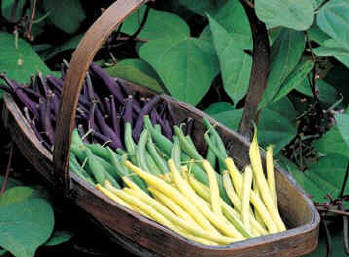Shirley Lindsey
Adams County Master Gardener
 Many first-time gardeners are looking for something to grow that will be easy, tasty, productive, and quick to grow. Green beans fill the bill for all these requirements. Green beans or snap beans were once called string beans because a tough
string had to be stripped off each side. Now you only need to snap or cut off the stem end!
Many first-time gardeners are looking for something to grow that will be easy, tasty, productive, and quick to grow. Green beans fill the bill for all these requirements. Green beans or snap beans were once called string beans because a tough
string had to be stripped off each side. Now you only need to snap or cut off the stem end!
Two types of green beans are bush type and pole beans. Pole beans must be supported. Usually 3 long sticks are fastened at the top, and the beans climb up this structure. You can buy these supports at garden centers. In addition to green snap beans, there are yellow snap beans, also called yellow
wax beans. You can also plant lima beans. Limas need a longer growing season. They are harvested when the pods are filled out, but still green and glossy.
 Kidney beans and navy beans are called shell beans or dried beans. They stay on the vine until they are dry and then are easily popped out of the pod. These may be stored for a long time. Their growing season may be up to 100 days. One dried bean I like to plant is the soldier bean. It is white and
where it comes off the pod, you can see a dark red soldier standing straight and tall. Children love to help harvest these beans.
Kidney beans and navy beans are called shell beans or dried beans. They stay on the vine until they are dry and then are easily popped out of the pod. These may be stored for a long time. Their growing season may be up to 100 days. One dried bean I like to plant is the soldier bean. It is white and
where it comes off the pod, you can see a dark red soldier standing straight and tall. Children love to help harvest these beans.
Although children often turn up their noses toward any green vegetable, they will usually be much more interested in eating something they have had a hand in producing. Even young children enjoy helping in the garden. Like the ‘Little Red Hen,’ they will feel they have an investment in the project
when they help with each step. One of my fondest memories of my daughter’s childhood is when we sat on the stone wall and shelled the dried beans we had raised.
Many people preserve green beans for use after the garden is done. They may be frozen, canned, or pickled. Yes, ‘pickled.’ Recipe to follow. Green beans are an excellent source of Vitamin K, Vitamin C, and manganese. They are a very good source of Vitamin A, potassium, folate, and fiber.
As with any vegetable, beans need nutrients. You may want to work some compost into the soil before planting. Also they will grow better if weeds don’t grab the nutrients in the soil or shade them from the sun. It is much easier to control weeds when they are small. Mulch helps keep weeds under
control, as well as keeping the soil from drying out.
A bush bean variety I like to plant is called ‘tendergreen.’ Plant seeds directly into the prepared soil bed, and these will produce in less than 2 months. Caution: do not plant seeds until the danger of frost has passed. In our area the recommendation is after Mother’s Day. My husband, the "Veggie
King," in our family, says that even if you don’t have frost, the ground is still too cold to encourage growth before that time.
Planting beans is so much fun because the seed is larger than many other vegetables. This is a good project to involve children. Sow the beans about 3 inches apart and cover each with about 1 inch of fine soil. Pat the soil lightly over the seeds. You will see the new plants in a week or two. Then
(this is the hard part) when the seedlings are a couple inches tall, thin them out until the plants are about 6 inches apart. This provides room to grow and makes available more of the nutrients in the soil.
In our garden we space out several plantings - maybe about 2 weeks apart in order to have fresh beans from June until frost. If you don’t have room for this, you may want to share your seed pack with another gardener. It is best to use your 2009 seeds this year. You can use older seeds, but fewer
will sprout.
Beans have few problems but may attract Mexican bean beetles. These are small (about 1/3 inch) oval or round beetles. They are yellow or brownish with 16 black spots. Their yellow eggs are laid on the underside of the leaf. If you see only a few, you can pick them off by hand. We sometimes put
powder (insecticide) in a jar with holes punched in the top. We sprinkle this over the plants early in the day when the dew is still on the leaves.
Since this column has gotten long enough already, there will be another with recipes for using beans. This will come later in the season when the beans are ready to harvest.
Read other articles on growing herbs or vegetables
Read other articles by Shirley Lindsey